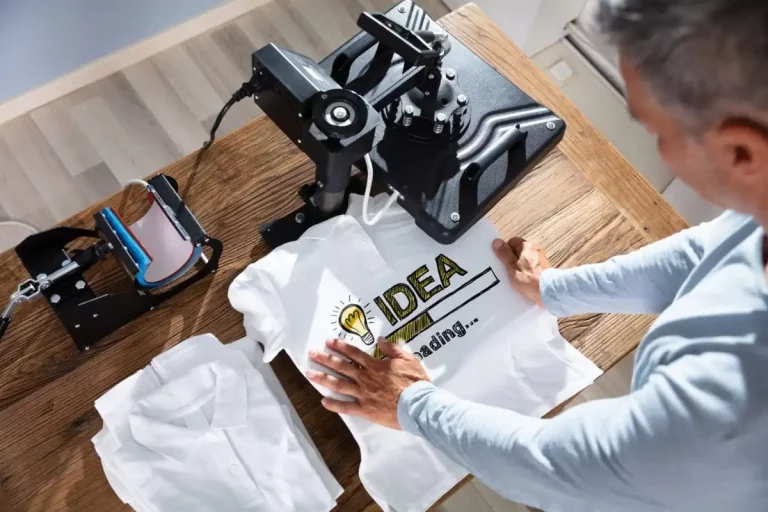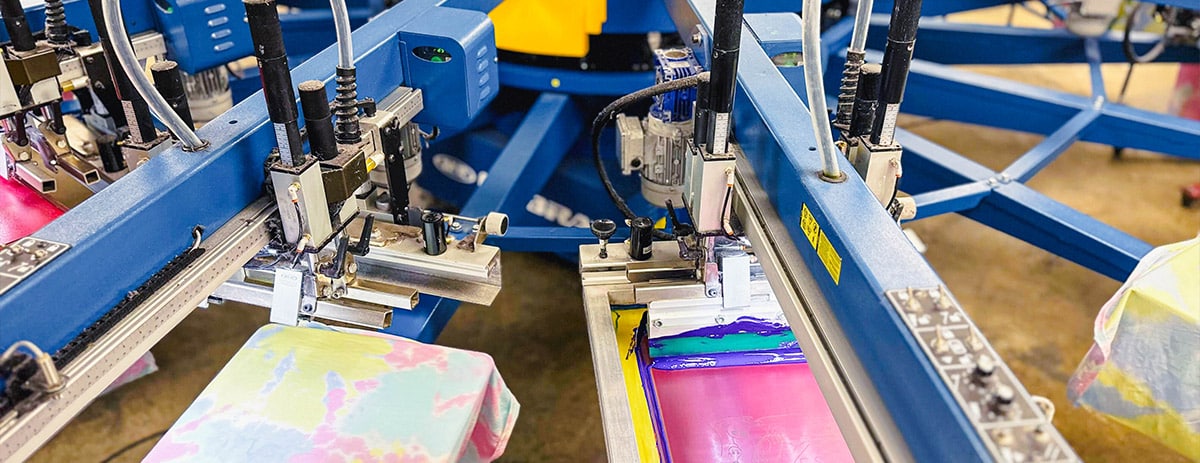Premium Screen Printing Kit for Business Startups
Premium Screen Printing Kit for Business Startups
Blog Article
Screen Printing Uncovered: Every Little Thing You Need to Know About Tee and Garment Printing Strategies
Display printing is a remarkable technique that integrates art with method, providing endless opportunities for imagination. Prepared to explore the essential components that make display printing an art form?
The Basics of Display Printing: Exactly How It Functions
When you dive into display printing, you'll uncover it's both a scientific research and an art. At its core, display printing involves creating a stencil, or screen, that permits ink to pass with only in particular areas.
Next, you'll mix your inks and prepare your printing surface. Setting the screen over the fabric, then utilize a squeegee to push ink with the display onto the garment. This procedure calls for precision, as you want clear, vibrant prints. After printing, you'll treat the ink with heat, guaranteeing it sticks to the fabric and lasts with cleans. Each step is crucial, and mastering them will certainly elevate your screen printing skills, transforming simple garments into one-of-a-kind, meaningful items.
Kinds of Screen Printing Methods
When you realize the fundamentals of display printing, it's time to check out the various strategies that can boost your layouts. One popular method is typical screen printing, where ink is pushed with a stenciled display.
If you're intending for great information, take into consideration discharge printing. This strategy eliminates dye from the fabric, leaving a soft, classic look. Another option is plastisol printing, understood for its sturdiness and vivid colors, making it a favored for many brands. Experiment with halftone printing to create slope results and intricate styles. Each method has its one-of-a-kind appeal, so don't be reluctant to attempt them out to locate what fits your design best!
Crucial Devices for Display Printing
To attain spectacular outcomes in screen printing, having the best tools is fundamental. You'll need a sturdy display printing structure, which holds the mesh that moves your layout onto the garment. Next off, spend in high-grade mops; these are important for applying ink uniformly across the screen.
Selecting the Right Inks and Materials
When choosing inks and materials for screen printing, you need to take into consideration the sort of ink that functions best for your project. Consider material compatibility to guarantee your layouts look great and last lengthy. Also, discover eco-friendly ink options to make your printing procedure much more lasting.
Types of Display Inks
Selecting the appropriate display ink is vital for attaining vibrant, long lasting prints that fulfill your job's demands. There are numerous sorts of screen inks to examine. Plastisol ink is prominent for its convenience and convenience of use, supplying superb shade opacity on dark materials. Water-based ink, on the various other hand, provides a softer feeling and is environmentally friendly, making it optimal for those looking to decrease their ecological impact. Release inks get rid of dye from the fabric, causing a soft, classic appearance but call for particular handling. Ultimately, specialty inks, such as metal or glow-in-the-dark, can include distinct effects to your layouts. Review your task demands and pick the ink that aligns best with your wanted end result.

Material Compatibility Considerations
Recognizing fabric compatibility is vital for attaining top notch screen prints, particularly given that various products react distinctly to various inks. Always test your inks on example fabric to assure they stick appropriately and maintain shade integrity. In addition, keep in mind that textile weight and texture can affect the last outcome, so picking the right ink and product combo is essential for your project's success.
Eco-Friendly Ink Options
Eco-friendly inks are coming to be a popular option for display printers who want to minimize their environmental impact while maintaining top quality. When picking inks, consider water-based inks, which are much less damaging and simpler to clean up contrasted to typical solvents.
Additionally, search for inks made from eco-friendly resources, such as soy or vegetable-based options. By picking the appropriate inks and products, you'll not just create spectacular designs however also add to a more sustainable printing procedure. Make the button, and your prints will certainly reflect your dedication to the setting!
Preparing Your Layout for Display Printing

Submit Format Requirements
To guarantee your design looks vibrant and sharp on fabric, you'll need to pay close attention to submit format demands for display printing. Make certain your design has a transparent background to stop undesirable white edges on your prints. Keep shade settings in mind; CMYK is typical for screen printing, so transform your RGB makes accordingly.
Shade Splitting Up Techniques
Color splitting up is an essential action in preparing your design for screen printing, and understanding it can significantly enhance your print high quality. You'll need to damage your layout into individual shades, as each color needs a separate display during printing. This precision not just assures exact color representation but also improves the printing process.
Resolution and Size
Attaining the ideal outcomes in screen printing begins with guaranteeing your style has the right resolution and size. Preferably, your artwork should go to least 300 DPI (dots per inch) for sharp, clear prints. If you make use of lower resolution, your final product investigate this site might look amateur and pixelated.
When it comes to size, think about the measurements of your print location. Layout your artwork to match the last print dimension, ideally producing it in the real dimensions you'll be publishing. This means, you'll stay clear of any unexpected scaling issues.
Constantly inspect your design in both vector and raster layouts. Vector graphics can be scaled without shedding high quality, making them perfect for display printing. Preparing appropriately will ensure your design looks outstanding on every garment!
Step-by-Step Display Printing Refine
Screen printing is a dynamic procedure that allows you to create lively layouts on different surfaces. To start, you'll need a display, solution, and your selected ink. Prepare your display by cleansing it completely. Next, apply the solution equally and let it completely dry in a dark location. As soon as dry, reveal your screen to light with your design positioned on it, which will solidify the solution where the light hits, creating a pattern - screen printing kit.
After cleaning out the unexposed emulsion, your display prepares. Establish it up on your printing surface area and straighten your garment under it. Pour ink onto the display and utilize a squeegee to push the ink with the pattern onto the material. Lift the display thoroughly and allow the print dry. Cure the ink utilizing warmth to assure durability. That's it! You've effectively screen printed your design.
Tips for Effective Screen Printing Projects
While you're diving right into your display printing tasks, remember that preparation is crucial to success. Begin by gathering all your materials-- inks, displays, mops, and garments. A clean workspace helps stop undesirable mistakes, so tidy up prior to you begin.
Next, confirm your art work is high-resolution and appropriately sized for your garment. Examine your screen for appropriate direct exposure and clean it completely to avoid smudges. When blending your inks, comply with the producer's standards to achieve the right uniformity.
Throughout web link printing, use also stress with your squeegee for regular results. Do not hurry; take your time to verify each print satisfies your standards. After printing, let your garments dry completely prior he said to handling or packaging them.
Lastly, always maintain an example of your job for future recommendation. In this manner, you can evaluate your progress and enhance your strategies with time. Delighted printing!

Regularly Asked Questions
The length of time Does It Require To Establish a Display Printing Task?
Establishing a screen printing task generally takes about thirty minutes to an hour. You'll prepare the screens, mix inks, and change the press. The moment varies based on intricacy and experience, so remain arranged!
Can I Publish on Different Fabric Types Making Use Of the Same Method?
Yes, you can print on various fabric kinds utilizing the same strategy, however you'll require to adjust your settings and inks. Some textiles absorb ink in different ways, so exploring warranties the very best results for every product.
What Prevail Errors to Avoid in Screen Printing?
When screen printing, avoid usual blunders like making use of the wrong ink, overlooking appropriate exposure times, or missing pre-press checks. Constantly evaluate your setup and maintain tidy displays to guarantee quality results each time.
Just How Can I Effectively Tidy and Keep My Screen Printing Tools?
To effectively tidy and maintain your display printing equipment, you should consistently wash screens with proper solvents, check squeegees for wear, and assure all tools are stored completely dry and dust-free. Consistency prevents expensive fixings and enhances performance.
Is Display Printing Ecologically Pleasant Compared to Other Techniques?
Screen printing can be a lot more eco-friendly than various other techniques, particularly if you use eco-conscious materials and water-based inks. By picking lasting supplies and practices, you minimize waste and decrease your effect on the world.
Display Printing Uncovered: Whatever You Need to Know About Tee and Garment Printing Methods
At its core, screen printing entails creating a stencil, or display, that enables ink to pass through only in particular areas. Placement the display over the textile, after that make use of a squeegee to push ink via the display onto the garment. One prominent approach is standard display printing, where ink is pushed via a stenciled screen.When selecting inks and materials for display printing, you require to take right into account the kind of ink that works best for your project.
Report this page